SWEDISH SOUTH ASIAN STUDIES NETWORK
India

Official
Name: Republic of India (English); or Bharat (Sanskrit).
Area: 3.166.829 sqkm.
Population: 1,138,316,276 (est. July, 10, 2007).
Official Census result in 2001:
1.027 015 247 (more
info about Census of India 2001).
Uttar Pradesh with a population
of more than 166 million holds distinction of being the most populous
state in the country followed by Maharastra (97 million) and Bihar
(83 million). The other large states, in terms of population size are
West Bengal (80 million),Andhra Pradesh (76 million), Tamil Nadu (62
million), Madhya Pradesh (60 million), Rajsthan (57 million) and Gujrat
(51 million). These states together account for 76 percent of the total
population of the country.
The total number of Urban Agglomerations (UA) with more than one
million populations is 35. Mumbai UA with 16.04 million population is
the largest, followed by Kolkata UA (13.2 million)
and Delhi UA (12.9 million).
Independent: 15 August, 1947, from Great Britain.
Languages: The Indian languages belong to four different linguistic families. A majority of the people speak Indo-European languages, to which belong e g Hindi, Bengali, Nepali, Marathi, Sindhi and Punjabi. These languages are spoken throughout Northern and Central India. 74 per cent of the population speak any of these languages who come out of the ancestral language Sanskrit.
The second major group – the Dravidian languages – are mostly spoken in Southern India. 24 per cent of the population speak Dravidian languages, to which belong Telugu, Tamil, Kannada and Malayalam.
The
third group – the Munda languages –
belong to the Austro-Asiatic linguistic family, represented by a few million
tribal people, amongst them the Santhals in Central and Eastern India.
The fourth and last linguistic family represented in India is the Tibeto-Burman
languages group, spoken by small communities in the Himalayas and in Northeastern
India along the borders to China and Myanmar (Burma). Only two per cent
of India´s population belong to these two latter linguistic families.
Till 2003, India had 18 official languages (now 22):
| Hindi | 402,2 Millions | Bengali | 83,0 Millions |
| Telugu | 78,7 Millions | Marathi | 74,5 Millions |
| Tamil | 63,2 Millions | Urdu | 51,8 Millions |
| Gujarati | 48,5 Millions | Kannada | 39,0 Millions |
| Malayalam | 36,2 Millions | Oriya | 33,5 Millions |
| Punjabi | 27,9 Millions | Assamese | 15,6 Millions |
| Kashmiri | 3–4 Millions | Sindhi | 2,5 Millions |
| Nepali | 2,5 Millions | Konkani | 2,1 Millions |
| Manipuri | 1,5 Millions | Sanskrit | 2 946 individuals |
+
Other languages – 37,1 Millions.
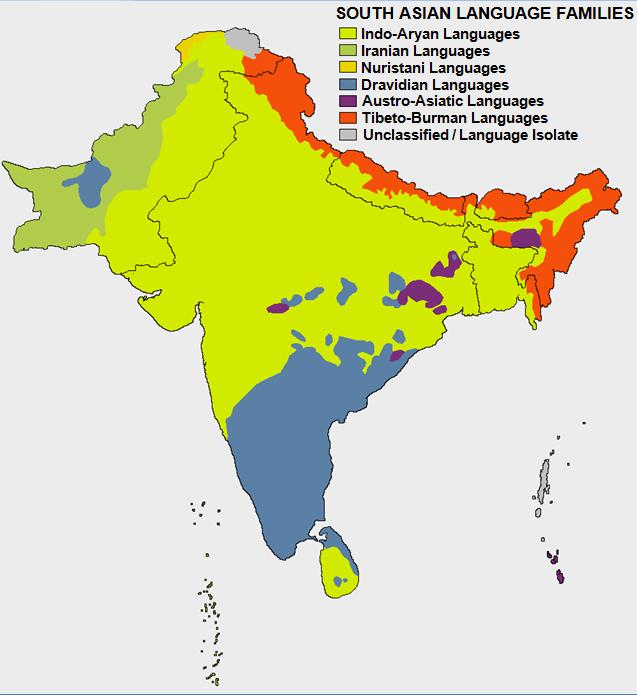 These data are estimations based upon the proportional representation
of native languages in the results of the 1991 Census, and calculated
upon a total population of 1 000 Million people. No Census could be made
in Kashmir in 1991, so for that state the estimations are based upon the
results of the 1981 Census.
These data are estimations based upon the proportional representation
of native languages in the results of the 1991 Census, and calculated
upon a total population of 1 000 Million people. No Census could be made
in Kashmir in 1991, so for that state the estimations are based upon the
results of the 1981 Census.
The Eighth Schedule to the Indian Constitution now contains a list of 22 scheduled languages – the 18 languages listed above, plus another four languages – Bodo, Maithili, Dogri, and Santhali – that were added to the 8th Schedule via the 92nd Constitutional amendment in 2003.
Article 343 of the Indian Constitution also allows for the continuation of use of the English language for official purposes in India, and as a link language. It still plays an enormous role in Indian society. Exact figures do
not exist, but approximately two per cent of the Indian population uses
English as their native tongue, which means 20 million people, and the
total amount of Indians who speak and understand English is estimated
to be more than 200 million.
At the time the constitution was enacted, inclusion in this list meant that the language was entitled to representation on the Official Languages Commission, and that the language would be one of the bases that would be drawn upon to enrich Hindi, the official language of the Union. The list has since, however, acquired further significance. The Government of India is now under an obligation to take measures for the development of these languages, such that "they grow rapidly in richness and become effective means of communicating modern knowledge." In addition, a candidate appearing in an examination conducted for public service at a higher level is entitled to use any of these languages as the medium in which he answers the paper.
Besides, individual states, whose borders are mostly drawn on socio-linguistic lines, are free to decide their own languages for internal administration and education. Thereby, several states have adopted official languages which are not among the 23 languages (incl. English) listed above. Examples include Kokborok in Tripura, Mizo in Mizoram, Khasi, Garo, and Jaintia in Meghalaya, and French in Pondicherry.
In 2004, the government elevated Tamil to the newly created official status of ”Classical Language”, followed by Sanskrit in 2005.
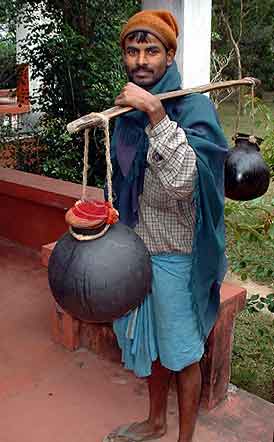 Religions: Hindus 80,5 p.c, Muslims 13,4 p.c, Christians 2,3 p.c, Sikhs 1,9 p.c,
Buddhists 0,8 p.c, Jains 0,4 p.c, Other religions & persuasions –
mainly tribal religions, but also including 69.601 Zoroastrian individuals
– 0,6 p.c (according to Census of India 2001). The first Report
on Religion based on the 2001 Census was released on 6 September 2004.
The detailed statistics provide information on distribution of population
by religion at India, state and district level. For the first time in
Independent India, datasets are made available showing population in the
age group 0 to 6 years, number of literates and category and type of workers
among the major religious groups.
Religions: Hindus 80,5 p.c, Muslims 13,4 p.c, Christians 2,3 p.c, Sikhs 1,9 p.c,
Buddhists 0,8 p.c, Jains 0,4 p.c, Other religions & persuasions –
mainly tribal religions, but also including 69.601 Zoroastrian individuals
– 0,6 p.c (according to Census of India 2001). The first Report
on Religion based on the 2001 Census was released on 6 September 2004.
The detailed statistics provide information on distribution of population
by religion at India, state and district level. For the first time in
Independent India, datasets are made available showing population in the
age group 0 to 6 years, number of literates and category and type of workers
among the major religious groups.
Scheduled
Castes & Scheduled Tribes: 16,48 p.c. and 8,08 p.c. respectively
(according to Census of India 1991; excl Jammu & Kashmir). State with
highest proportion of Scheduled Castes: Punjab, 28,3 p.c. State with highest
proportion of Scheduled Tribes: Mizoram, 94,8 p.c.
Population
growth rate: 1,606 p.c. (est. 2007)
Life
expectancy at birth:
68.59 years (est. 2007)
Literacy
rate: 61 p.c. (Census 2001)
GDP
Purchasing power parity: 3,800 USD (est. 2006)
Population
below poverty line: 25 p.c. (est. 2002)
Republic: Since 26 January 1950. India’s constitution is available
on the Internet. Go
for the constitution.
National
Anthem:
Jana gana mana (Music and Lyrics by Rabindranath Tagore).
Administration: Federal state, consisting of 29 States (Andhra
Pradesh, Arunachal Pradesh, Assam, Bihar, Chhattisgarh, Delhi, Goa,
Gujarat, Haryana, Himachal Pradesh, Jammu & Kashmir, Jharkhand, Karnataka,
Kerala, Madhya Pradesh, Maharashtra, Manipur, Meghalaya, Mizoram, Nagaland,
Orissa, Punjab, Rajasthan, Sikkim, Tamil Nadu, Tripura, Uttarakhand
(2002–2006 called Uttaranchal), Uttar Pradesh and West Bengal)
and six Union Territories – Andaman & Nicobar Islands, Chandigarh,
Dadra & Nagar Haveli, Daman & Diu, Lakshadweep and Pondicherry.
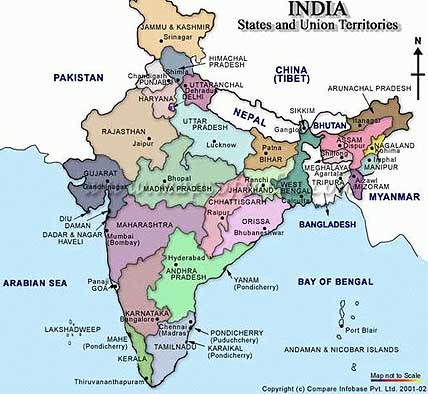 The
State Governors are appointed by the president whereas the Chief Ministers
are members of popularly elected State legislative assemblies. The Constitution
allows central control of state government (President's Rule) during time
of emergency on recommendation of governor. The centrally controlled Union
Territories are led by Lieutenant Governors or Chief Commissioners, appointed
by the President.
The
State Governors are appointed by the president whereas the Chief Ministers
are members of popularly elected State legislative assemblies. The Constitution
allows central control of state government (President's Rule) during time
of emergency on recommendation of governor. The centrally controlled Union
Territories are led by Lieutenant Governors or Chief Commissioners, appointed
by the President.
Capital: New Delhi.
Recent history: The Congress Party
dominated Indian politics during several decades, right from Independence
in 1947, primarily under the leadership of the Prime Ministers Jawaharlal
Nehru, Indira Gandhi and Rajiv
Gandhi, but the party lost during the 1990´s its leading
position. India has instead since 1996 been ruled by coalition governments,
1996–98 by centre-left coalitions supported from the outside by the
Congress(I), 1998–2004 by a government dominated by the hindu nationalist
Bharatiya Janata Party, BJP, that ruled along with a large number of regional
parties in a coalition named NDA, National Democratic Alliance.
On Friday 6 February 2004 the lower house of parliament was dissolved
six months ahead of the scheduled general elections. Elections were then
held in April–May 2004. The results were totally unexpected, the
NDA government led by Prime Minister Atali Behari
Vajpayee was defeated by a coalition led by the Congress Party,
the United Progessive Alliance, UPA, supported by the leftist parties
that also made a sensationally good result.
In the 2009 elections to Lok Sabha, held during April-May (the final results declared on May 16th), the Congress Party defended its position and will again form the government for the 15th Lok Sabha.
The
present political situation
can be studied at the Indian
parliament web site. Out of the 545 mandates in Lok Sabha, the Lower
House of the Indian Parliament, 543 are elected. The remaining two seats
are meant for representatives of the Anglo-Indian community, and they
are nominated by the President of India.
Elections were last held in 2008. Current situation (Sept. 2010) partywise:
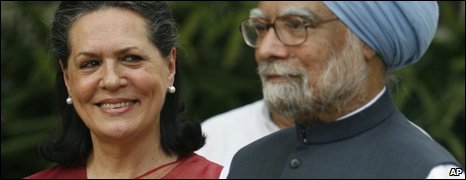
United Progressive Alliance (UPA):
• Indian National Congress (INC) 208
• All India Trinamool Congress 19
• Dravida Munnetra Kazhagam (DMK) 18
• Nationalist Congress Party (NCP) 9
• Jammu & Kashmir National Conference 3
• Jharkhand Mukti Morcha 2
• Muslim League Kerala State Committee 2
• All India Majlis-e-Ittehadul Muslimeen 1
• Kerala Congress (M) 1
• Viduthalai Chiruthaigal Katchi 1National Democratic Alliance (NDA):
• Bharatiya Janata Party (BJP) 116
• Janata Dal (United) 20
• Shiv Sena 11
• Rashtriya Lok Dal 5
• Shiromani Akali Dal 4
• Telangana Rashtra Samiti 2
• Asom Gana Parishad (AGP) 1Left Front:
• Communist Party of India (Marxist), CPI(M) 16
• Communist Party of India (CPI) 4
• All India Forward Bloc 2
• Revolutionary Socialist Party 2Other parties:
• Samajwadi Party 22
• Bahujan Samaj Party (BSP) 21
• Biju Janata Dal 14
• All India Anna Dravida Munnetra Kazhagam 9
• Telugu Desam 6
• Rashtriya Janata Dal (RJD) 4
• Janata Dal (Secular) 3
• All India United Democratic Front 1
• Bahujan Vikas Aaghadi 1
• Bodoland People’s Front 1
• Haryana Janhit Congress (BL) 1
• Marumalarchi Dravida Munnetra Kazhagam 1
• Nagaland People’s Front 1
• Sikkim Democratic Front 1
• Jharkhand Vikas Morcha (Prajatantrik) 1
• Swabhimani Paksha 1
• Independents 8= 543
+ 2 nominated Anglo-Indian seats
= Total 545The percentage of votes for the national parties were as follows:
INC: 28.55 %
BJP: 18.80 %
BSP: 6.17 %
CPI(M): 5.33 %
NCP: 2.04 %
CPI: 1.43 %
RJD: 1.27 %
More information on the political situation in each of the 29 States (including Delhi) and six Union territories can be found on the Indian Government official web site.
President since July, 25, 2007: Pratibha Patil, candidate
of the governing Congress party and its political allies. (Photo to the right)
Other
leading politicians on the government side (including Left Front allies):
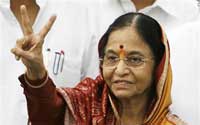 Sonia Gandhi, chairman, Indian National Congress,
and convenor, United Progessive Alliance
Sonia Gandhi, chairman, Indian National Congress,
and convenor, United Progessive Alliance
Arjun Singh, Pranab
Mukherjee, Shivraj Patil, and P.
Chidambaram, Indian National Congress
Sharad Pawar, National Congress Party
Farooq Abdullah, Jammu & Kashmir National
Conference
Mamata Bannerjee, Trinamul Congress
M Karunanidhi, Dravida Munnetra Kazhagam
– DMK
Important opposition politicians in the
NDA alliance:
Lal Krishna Advani, BJP
George Fernandes, Janata Dal (United)
Other
important opposition politicians:
Mulayam Singh Yadav, Samajwadi Party
Mayawati, and Kanshi
Ram, Bahujan Samaj Party
Ms J Jayalalithaa, All India Anna Dravida
Munnetra Kazhagam – AIADMK
Laloo Prasad Yadav, Rashtriya Janata Dal
Ram Vilas Paswan, Lok Jan Shakti Party
Harkishen Singh Surjeet, and Jyoti
Basu, Communist Party of India (Marxist) – CPI(M)
Chandrababu Naidu, Telugu Desam Party
Wikipedia, the free encyclopedia, India
BBC News Country profile India
The Human Development Report 2009 data on India
The Planning commission of the Government of India offers a wealth of useful information on the country and its development.
The Library of Congress, USA, offers through its Country Studies Web site detailed Information on all Aspects of Countries round the Globe. Look for India. Information contained in the Country Studies On-Line is not copyrighted and thus is available for free and unrestricted use by researchers. As a courtesy, however, appropriate credit should be given to the series. Unfortunately, though, the information on India is not updated since September 1995.
World Bank Group/India: Constantly updated data reports, publications, statistics, projects etc, for India
CIA – The World Factbook: India
The Swedish Government’s Division for Democratic Issues, based at the Ministry of Justice, publishes yearly reports about the human rights situation in countries all over the World. Read the 2007 Report on the Human Rights Situation in India (in Swedish only).
The British Foreign & Commonwealth Office (FCO) advice on safety aspects on travelling to India

SASNET - Swedish South Asian Studies Network/Lund
University
Address: Scheelevägen 15 D, SE-223 70 Lund, Sweden
Phone: +46 46 222 73 40
Webmaster: Lars Eklund
Last updated
2010-09-21
